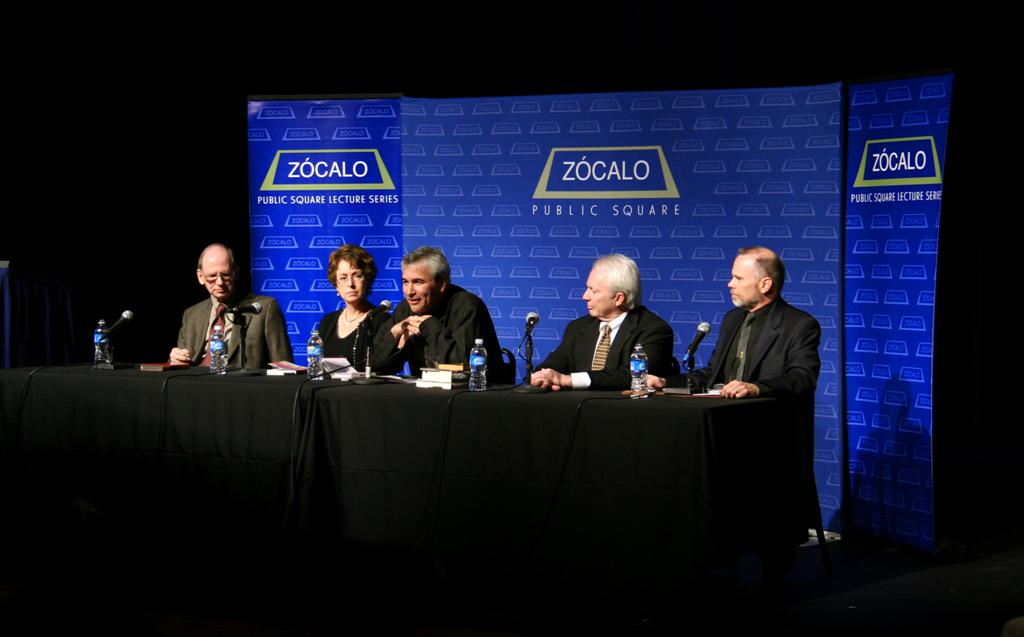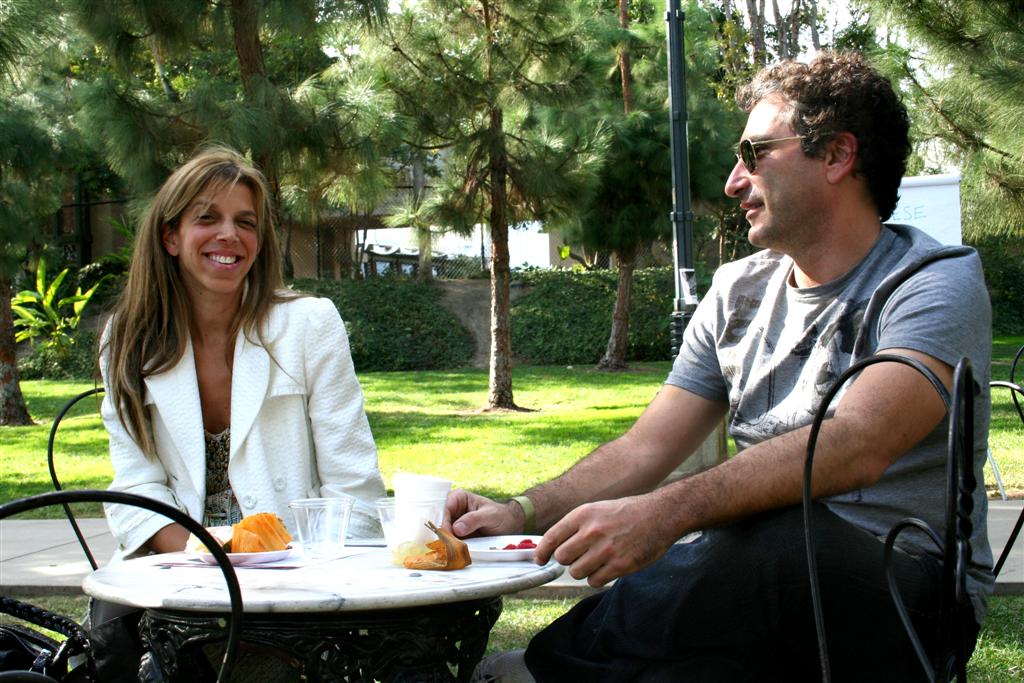
No matter how brightly the sun shone on Barnsdall Park and how peacefully park-goers pursued tai chi and kickboxing lessons on the grass, inside the darkened Barnsdall Gallery Theatre, an all-star panel of Dashiell Hammett experts talked about the man whose Maltese Falcon defined noir and who belongs, as moderator and National Endowment for the Arts Director of Literature David Kipen put it, on the “Mount Rushmore of detective writing.” And, at least according to these sharp-tongued but convivial panelists, brought together by Zócalo, the Los Angeles Department of Cultural Affairs and the NEA’s Big Read program, the writer should perch just as high if not higher than Raymond Chandler and Nobelists like Sinclair Lewis.
Making literature from mystery
Hammett had the raw material that others (notably Chandler) had to fabricate when making mystery tales-experience working as a detective for the elite Pinkerton squad. As Richard Layman, author of six works on Hammett, said, “It doesn’t mean he was a bank guard somewhere. He was operating at the very highest level of professionalism.” It was here he learned to file such precise suspect reports that his colleagues could capture fugitives based on Hammett’s words alone. The experience shaped him in a way similar, Kipen noted, to Ernest Hemingway’s work sending dispatches to The Kansas City Star.
Hammett also practiced his craft regularly in the years before he wrote his most famous work. He penned stories for the pulp magazine Black Mask from 1922  onward, with stories that started out as what Layman called merely “publishable.” But Hammett continued to pursue his quest to “make literature out of the detective form.”
onward, with stories that started out as what Layman called merely “publishable.” But Hammett continued to pursue his quest to “make literature out of the detective form.”
The Maltese Falcon succeeded on that front, winning praise and selling north of 10,000 copies (though it was not among the bestsellers of 1930; Thornton Wilder’s name is the only familiar one of that group). Tom Nolan, biographer of detective writer Ross Macdonald, said that the book’s social realist style set it apart from the “artificial detective fiction we had at that time,” like the work of S. S. Van Dine. Its narrative perspective-which offers readers no information beyond what detective Sam Spade knows, roping them into the detective role-recalled Sherlock Holmes stories, Nolan noted.
His descriptive style was so precise that, when he explained how to roll a cigarette, Kipen said, “a Martian who had never seen a cigarette could figure out how to roll one.” Body language was so well-choreographed on the page that the book seemed predisposed to the screen.
Bogart as the blond satan…
But however close-hewed an adaptation director John Huston accomplished, “it ain’t the book,” Layman said.
Though necessarily trimmer than the novel, the movie did preserve much of the original dialogue, if not by design. The apocryphal tale, as Kipen told it, goes something like this: Huston handed a copy of the novel to his secretary on a Friday afternoon and simply said, “Change the margins on this, we shoot Monday.”
Vince Emery, a publisher of Hammett stories who once lived in a San Francisco apartment mentioned in one of said tales, cut in and to the delight of the crowd, offered a second-hand version of the tale, told to him by Ray Bradbury: that a screenwriter friend of Huston’s highlighted the parts of the book he liked best and handed it to that critical secretary, who typed it up. Studio head Jack Warner came across the typed copy and, taking it to be a script, and a stellar one, told Huston to shoot it. (That copy of the script, Emery noted, was recently stolen from the home of a Beverly Hills collector. Perhaps, Kipen supposed, by the same man who stole the falcon itself nearly two years ago, reenacting the crime that launches Hammett’s novel.)
One significant switch in the movie was the selection of Humphrey Bogart as Sam Spade, not quite the broad-shouldered “blond satan” of the book, but similar in spirit. The other switch from book to film was the cutting out of the final scene of the novel and replacing it with a line of Shakespeare. And though some on the panel thought it was Huston who added it, Emery said Bogart added the bard. Hammett’s granddaughter Julie Rivett said, eliciting chuckles from the crowd, “I wouldn’t have thunk it.”
Hammett in Hollywood
Rivett, one of four Hammett grandchildren, said Hammett didn’t quite like the “ludicrousness of Hollywood.”
“He liked the money,” she continued, “but he didn’t like that he was taking the money.” He had his favored haunts-the Beverly Hilton, the Brown Derby – and met the woman who would be his paramour till death, Lillian Hellman, but he drank a lot during those L.A. years though, Rivett maintained, he was no “Hemingway-esque curmudgeon.” He was a gentleman, Rivett said, though he occasionally had a “wicked” sense of humor. She revealed one “wicked” prank: Hammett mailed out coupons requesting vacuum cleaner salesman to stop by Hellman’s rent-controlled New York apartment to show off their goods. So many showed up that Hellman got kicked out.
No colored bubbles
Emery recalled that Hammett’s final story came out in Colliers, a “slick expensive glossy magazine,” in the mid 1930s. He didn’t write mysteries again. His last attempt at a novel, called Tulip, ends with a character uttering words that might explain Hammett’s writerly silence, Layman suggested: “When you’re tired, you oughta quit, I think, and not try to fool your customers with colored bubbles.”
Hammett enlisted to fight in World War II, at age 49, and endured basic training again. During the McCarthy era he was accused of being a communist because of his participation in the Civil Rights Congress, as Layman explained in Q&A, maintaining that Hammett had no knowledge of more extreme wings of the group.
Hammett’s confrontation with McCarthy provoked at least one memorable exchange, Rivett recalled. McCarthy asked him if he were part of a government that had spent millions of dollars to stop communism, would he buy Hammett books to put in State Department libraries? Provoking an appreciative gasp from the crowd, Rivett said that Hammett replied, “If I were trying to fight communism, I wouldn’t give people any books at all.”
Hammett had no style?
Hammett was buried in Arlington Cemetery, though J. Edgar Hoover himself tried to stop it. And his books were nearly banned from government libraries, until, Kipen said, a fan named Dwight Eisenhower interposed.
Despite his 30 years without a writerly word, Hammett had a well-established legacy. Other writers-particularly Chandler-began their careers imitating Hammett. And Layman put his oeuvre into context: “Think of the great writers, and how many great novels they wrote.” Hemingway wrote three good ones, Layman argued, and so did Lewis. Hammett wrote “at least two masterpieces….What do you want from the guy?”
And how did he compare to Chandler? Layman got the last word on the great Northern California-Southern California noir rivalry, provoking the biggest reaction from the crowd, somewhere between cheer, gasp and groan. Layman recalled Hammett’s last interview, when the great author said, “It’s the beginning of the end when you recognize you have style.”
Layman paused, and finally said, “Chandler had style.”
*Photos by Aaron Salcido.




Send A Letter To the Editors